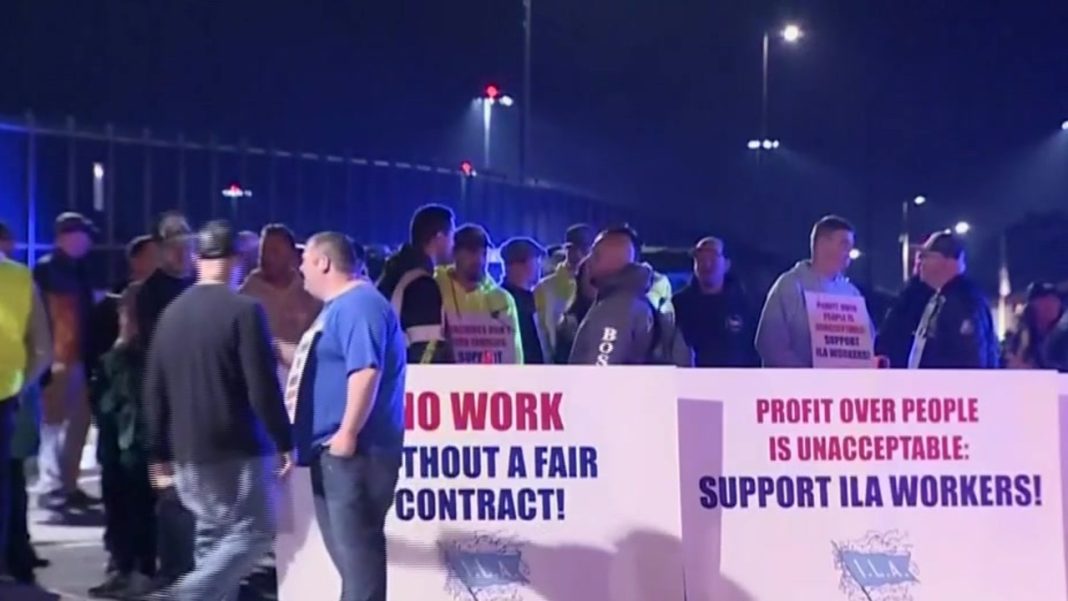In a significant labor action that has the potential to disrupt supply chains across the United States, dockworkers at 36 ports stretching from Maine to Texas have initiated a strike—the first of its kind in over four decades. This strike, which began early Tuesday morning, is rooted in workers’ demands for fair wages and protections against increasing automation in the workplace. As the contract between the ports and approximately 45,000 members of the International Longshoremen’s Association (ILA) expired at midnight, the implications of this action could reverberate through the economy, particularly as the holiday shopping season approaches.
At the heart of this strike lies a fundamental tension between labor and management. Workers at the Port of Philadelphia were seen walking picket lines, passionately chanting “No work without a fair contract.” They carried messages on trucks highlighting their concerns, such as “Automation Hurts Families: ILA Stands For Job Protection.” Local union president Boise Butler emphasized the urgency of their demands, stating, “Shipping companies made billions during the pandemic by charging high prices. Now we want them to pay back. They’re going to pay back.”
The economic stakes are high. A recent analysis from J.P. Morgan estimates that a prolonged strike could cost the economy between $3.8 billion and $4.5 billion each day. While consumers may not immediately feel the effects—thanks to retailers stocking up on goods ahead of the holiday season—delays could become significant if the strike extends beyond a few weeks. Essential imports, particularly perishables such as bananas, are likely to be affected quickly. The affected ports handle a staggering 3.8 million metric tons of bananas annually, comprising 75% of the nation’s supply.
Moreover, the impact of the strike could lead to a ripple effect, causing traffic congestion at ports on the West Coast. Although railroads have indicated they could increase freight capacity to help manage the backlog, experts contend they might not be able to compensate for the closed Eastern ports adequately. The potential for shortages looms large, particularly for items in high demand during the holiday season, such as toys and electronics.
The negotiations leading up to the strike had shown some promise, with both sides reportedly moving away from their initial wage offers. The ILA’s opening proposal sought a staggering 77% pay raise over six years, a demand that reflects both the rising cost of living and the historical context of stagnant wages. In contrast, the U.S. Maritime Alliance, representing the ports, countered with a 50% raise offer, which included increased employer contributions to retirement plans and enhanced healthcare options. However, the union’s insistence on a complete ban on automation complicates the negotiations, revealing a deep-rooted fear among workers about job security in an increasingly automated industry.
The timing of the strike is particularly poignant, coinciding with the lead-up to the presidential election. Historically, labor movements have played pivotal roles in shaping political landscapes, and this strike could certainly become a focal point in the upcoming election, especially if it results in widespread shortages. President Joe Biden, who has been actively courting union votes, has so far refrained from intervening in the strike through the Taft-Hartley Act, which would allow for an 80-day cooling-off period. This decision reflects a balancing act—supporting labor rights while also considering the broader economic implications.
As this unprecedented strike unfolds, the spotlight is firmly on the ILA and the U.S. Maritime Alliance. The outcome will not only determine the fate of nearly 45,000 workers but will also serve as a litmus test for labor relations in the U.S. The stakes are high, and the nation is watching closely. Will the union’s resolve stand strong against the backdrop of economic pressure, or will a compromise emerge that addresses the needs of both workers and employers? Only time will tell, but one thing is clear: the labor movement is alive and well, and its echoes will be felt long after the picket lines have cleared.

